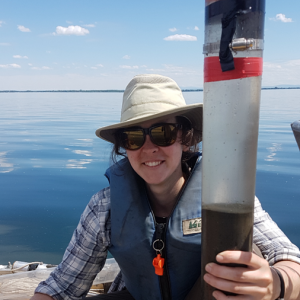
Katherine Moir
Ph.D. Candidate
Biology
Queen's University
2018 - 2020
Supervisor(s): Brian Cumming
Research Project: Cumulative impacts on algal assemblages in Lake St. Francis: The importance of multiple stressors
My research focuses on recent changes to the structure of communities of algae and cyanobacteria on the St. Lawrence River. High nutrient loads emanating from local, agriculturally intensive watersheds have historically driven shifts to assemblages of algae in lakes and rivers worldwide. However, climate-change impacts are being increasingly recognised as important drivers of algal community structure, particularly favouring the growth of cyanobacteria in temperate lakes. Recent work suggests that there has been an increase in the relative abundance of cyanobacteria in the St. Lawrence River over the past 10-15 years, yet it remains unclear whether climate change, nutrients, or other local stressors such as legacy metal contamination are driving this assemblage shift. My project uses paleolimnological methods to disentangle these stressors; responses of algae and cyanobacteria to changes in their environments are preserved in aquatic sediments, which can be examined for changes to community assemblages over time through the analysis of dated sediment cores. Determining the roles of these different stressors in structuring algal community composition on the St. Lawrence River will help inform remediation efforts, and will enhance our understanding of climate-change impacts on large river ecosystems.
Armstrong Z, Moir K, Windle MJS, Ridal JJ, Cumming BF. (2021) Ecological change associated with historic industrial activity in the St. Lawrence River at Cornwall, ON: A paleo-ecotoxicological assessment using subfossil chironomid assemblages. Journal of Great Lakes Research, 47(4): 1074-1085.
Moir KE, Windle MJS, Cumming BF, Ridal JJ. (2021) Nearshore Sedimentary Mercury Concentrations Reflect Legacy Point Sources and Variable Sedimentation Patterns Under a Natural Recovery Strategy. Environmental Toxicology and Chemistry, 40(6): 1788-1799.
Moir KE, Hickey MBC, Leavitt PR, Ridal JJ, Cumming BF* (2018). Paleolimnological proxies reveal continued eutrophication issues in the St. Lawrence River Area of Concern. Journal of Great Lakes Research, 44: 357-366